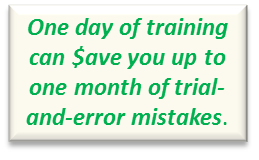|
Lab Life-Line Monthly
Practical Advice for the Busy Lab
from
ACCTA, Inc.
|
|
| Vol. 4, No. 4-5. April-May, 2015 |
|
How Long Does It Take To Learn HPLC?
I am often asked to provide a proposal/quote for in-lab HPLC training. Sometimes the lab has a specific idea about what they need, or how many days they want me to be on-site, or what their budget is. In many cases, however, I simply am asked how much it will cost or how long will it take. Unfortunately, the best answer is “it depends . . .”
As you know, I have visited many labs during the last 20+ years. Most of these visits were for training on HPLC hardware and/or software. Some visits were one day while others lasted an entire week. As you might guess, the amount of information that I can share is directly proportional to the amount of time I spend with the lab staff – more time = more training = more learning = more benefits for the lab.
Here are some “rules” that I have developed for training; all are essentially a variation on the same idea:
- There are no shortcuts to learning HPLC.
- I cannot pass along 30+ years of HPLC experience in one morning.
- Leaning HPLC is a process, not a product – a journey not a destination. I can only help you get started on your journey.
- I am still learning things after 30 years.
- For every day of training, I can save you about one month of trial-and-error learning, especially with software.
And, of course,
You get what you pay for.
The ideal situation is to tell me how much you want to learn and then accept what I estimate that will require. But in most cases, we do this backwards!
So, here is a quick summary of what we can accomplish based on time only.
One Day
For hardware I can talk a little bit about the technique you are using (e.g., reversed phase), briefly go over how each module works, and give some basic advice on things you should or should not do. Software training would be limited to how to start the program, where the major features are located, and how to perform basic tasks like acquisition and simple data analysis. The student will probably be able to operate the instrument using a very simple method and will have limited ability for doing anything other than running samples and printing out reports. Troubleshooting will probably not be possible. Significant supervision will be necessary after I leave.
Two Days
We can discuss hardware design in enough detail so that the staff have a reasonable idea of how the instruments works – critical information to begin learning troubleshooting techniques. We can also discuss operating modes and how their method functions, giving hints on what to expect for problems, and other ideas on things that can reduce errors and other problems. Discussions of troubleshooting are more complete, and the operator should be able to perform basic troubleshooting tasks. Software training over two days should allow a reasonable review of all the features of the program, although there would not be much time for examples and discussion. The operator would be able to perform most routine tasks and troubleshoot many common problems. Supervision would still be necessary for the first month or so, depending on the experience of the analysts.
Three Days
 |
|
In addition to the topics discussed in the two day option, we can add in more hands-on work with the actual lab methods, perhaps running samples and performing basic data analysis techniques. Existing methods could be installed, demonstrating parts of the software. The system can be calibrated and several samples analyzed to give the users some initial experience and maybe some exposure to potential problems. Some supervision would be necessary over the first few weeks, but the staff should be able to operate independently within a short time.
Four or Five Days
With almost a full week, we can almost completely introduce the software, hardware, and method. Some method optimization may even be possible, but the highest priority is giving the staff time to work with all parts of the technique and method, and ask as many questions as possible. These discussions near the end of the week allow me to “fine-tune” their understanding of all topics. In many cases, the extra one or two days allow most users to develop a much better “comfort level,” which means that they will be able to more confident working without me present.
After I Leave!
This is just as important as the initial training. If the training lasted less than four days, the most important activity for the students is to get into the lab immediately after I leave and begin working on the system. Managers, give them some time to develop some confidence before expecting them to be at full efficiency.
We are always happy to discuss your individual needs, and to help you develop a customized plan that will get your lab working better. Just contact us to discuss your situation.
|
"We can no longer wait for the storm to pass, we must learn to work in the rain."
– Peter Silas |
|
|
Other Training Events
|
|
11 August 2015
9 June 2015
4 November 2015
Troubleshooting Chromatographic Systems: Sunday, Nov. 15 - Monday, Nov. 16.
Sample Preparation: The Chemistry Behind the Techniques:
Tuesday, Nov. 17
·
Practical Guide to Performing HPLC and UHPLC Experiments in Reversed-Phase Mode: Wednesday, Nov. 18
|
| Download Section |
|
Minnesota Chromatography Forum, May, 2014:
|
|
Contact Details
Merlin K. L. Bicking, Ph. D.
ACCTA, Inc.
3534 Jessie Ct, Saint Paul, MN 55125 USA
Phone: +1 (651) 731-3670
Email:
info@accta.com
|
|
|
|
